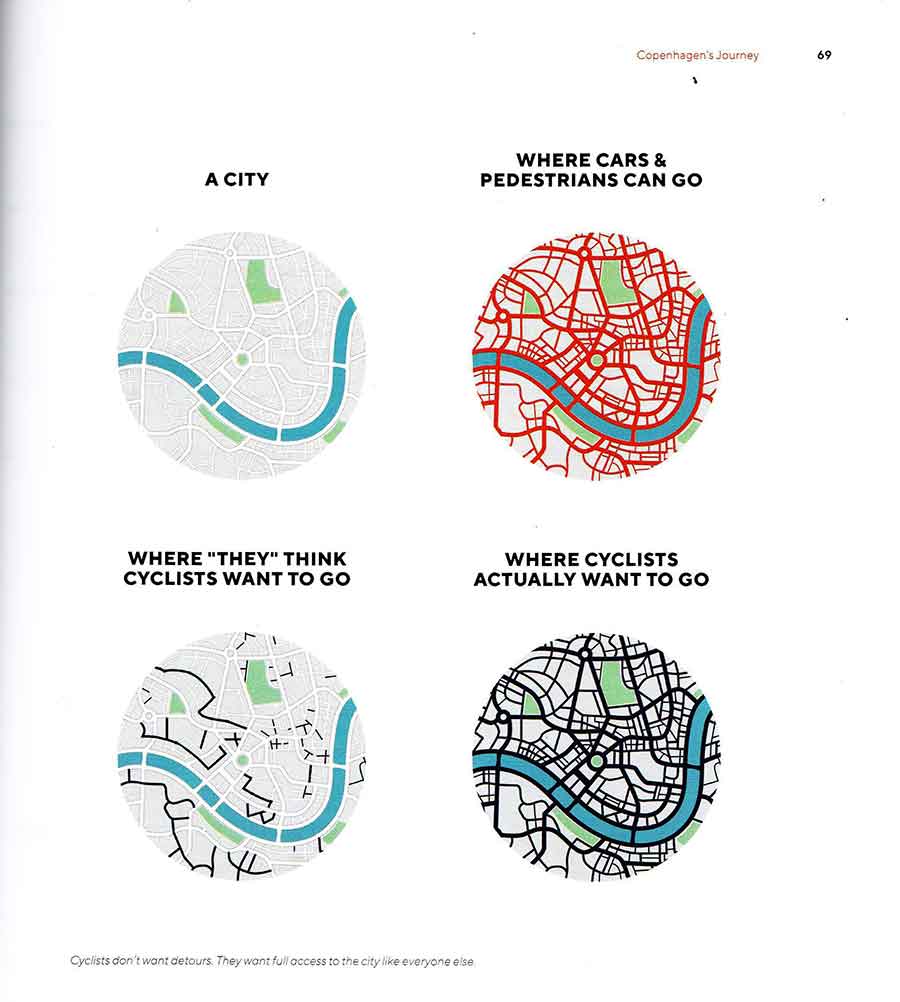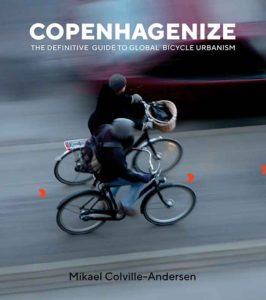How to integrate cycling with urban design: Copenhagenize

Copenhagenize: The Definitive Guide to Global Bicycle Urbanism by Mikael Colville-Andersen, Island Press, 2018, review by Tom Turner
The great strength of this book is its focus on bicycle planning being an aspect of urban design. Illustrations support this point: the book’s photographs are very good and its diagrams are really excellent. Thank you to Mikael and thank you to Island Press.
Planning for the bicycle must not be detached from other ways of using, interpreting and re-designing city landscapes. Personally, I am more supportive than Mikeal of the contribution transport engineers make to bicycle planning (even the Four step model for bicycle network infrastructure planning could be adjusted). But I agree that if traffic engineers are given exclusive responsibility for cycleways the results can be dire. ‘Exclusive’ in this context means excluding the necessary contributions of bicycle users and urban designers.

Transport planning began as a Modernist design process but is escaping, slowly, from this mould. The involvement of architects exemplifies a postmodern trend. Mikael is hard on Copenhagen’s Inner Habour Bridge (Inderhavnsbroen) for its random and aesthetically conceived changes of direction. The design is postmodernist. Calling it ‘a stupid, stupid bridge’ Mikael sees it as ‘a beastly thing that is completely and utterly out of place in the delicate urban, historical, and architectural context of its location’. So it’s time for a post-Postmodern approach to bicycle planning, resting on beliefs as much as on rational decision making. It should draw upon the work of Ian McHarg and on the theories associated with landscape urbanism.

Another strength of the book is its broad international perspective. Very understandably, there are few references to London in the book (I counted five). But many of the faults in bicycle planning identified remain to be learned in London. On p.70 Mikael lambasts the US proposal for ‘Bicycle Boulevards’. Acknowledging that the term may be ‘wide and fancy-sounding’ he explains that ‘A bicycle boulevard is, in fact, a detour that keeps cyclists away from the natural desire lines of a city – out of sight, out of mind – and does little to prioritize cycling as a transport form. Lazy bicycle planning. Band-aid solutions by politicians.’ Exactly the same idea with exactly the same faults is found in the TfL Transport for London Quietway programme. That’s why the first Quietway had 22% of London cyclist deaths in its first year of operation. [See Review of Q1 + Analysis of 2018 cycle fatalities in London.] Why don’t TfL employ Danish and Dutch bicycle planners?
Before TfL go any further with planning bi-directional cycle ‘superhighways’ it should read p.79 of this book: ‘Bidirectional cycle tracks pose a much higher risk to the cyclists than two one-directional ones. The difference on crossings is by a factor of 2’. When this lesson has been learned, TfL should modify its 2018 Action Plan for London Cycling to include a policy to switch from bidirectionality to unidirectionality.
Most countries have botched their cycle planning. A few countries, which Mikael Colville-Andersen has analysed, have learned how to make a better job of it. Why don’t the countries that are learning decide to learn from those that have learned? See p.175 ‘If, as I have said, the bicycle is the most important and powerful tool in our urban toolbox for making cities better…’.
For an example of the change that good bicycle planning can make to cities see:
And for more information see:
Costs, benefits and cost benefit ratios of Crossrail and a Londonwide Cycleway Network.
16 Principles for Cycleway Network Planning
Four step model for bicycle network infrastructure planning
Bicycle network planning and design : in Edinburgh, Cambridge and London
Notes:
- the term Copenhagenize has its origin in the British fleet’s confiscation of the Danish fleet in 1807
- here is a TedX lecture by Mikael Colville-Andersen
